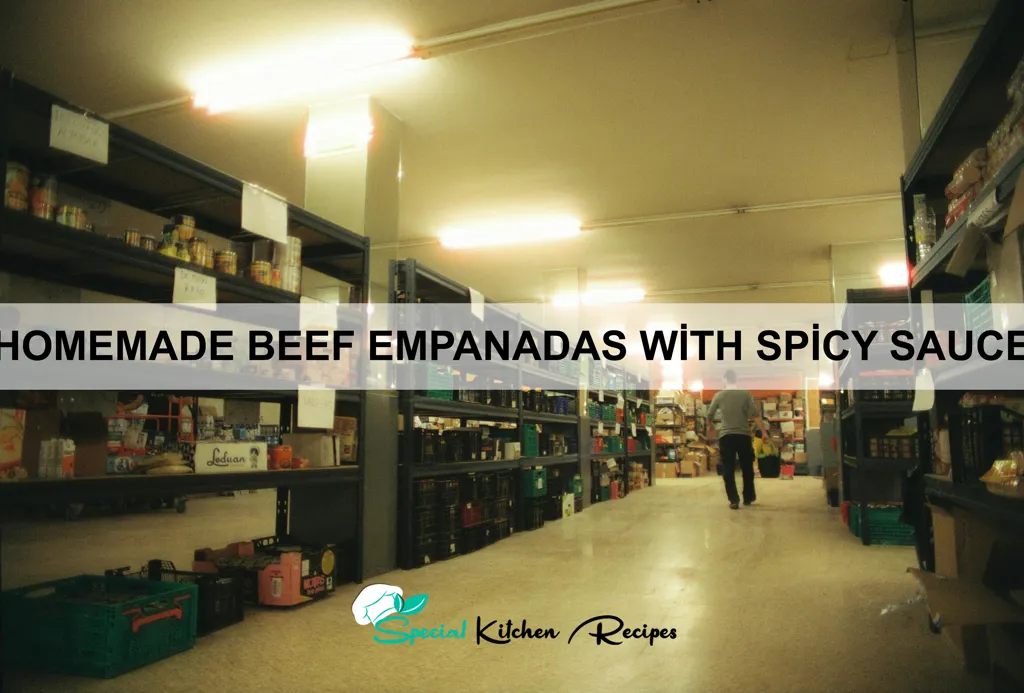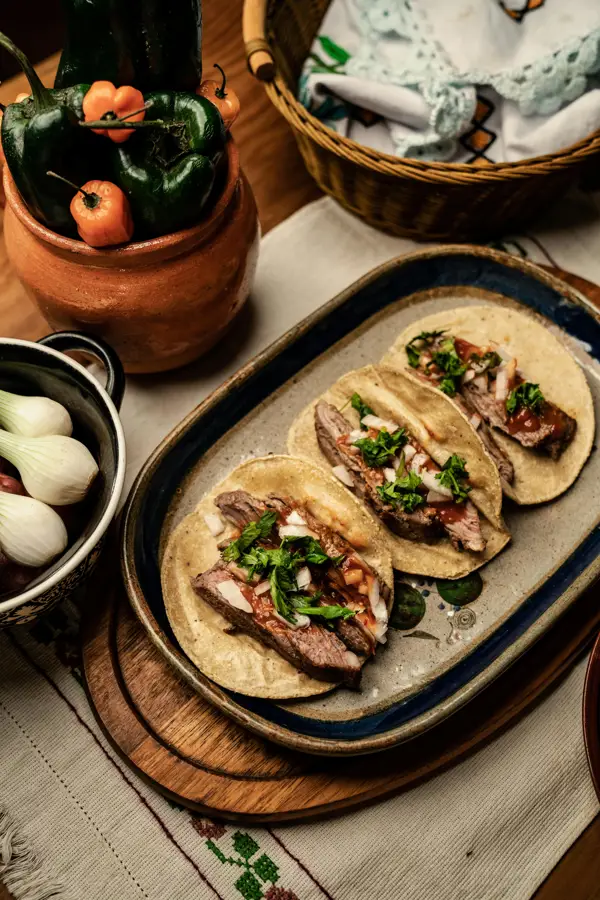Prepare your taste buds for a culinary journey to the heart of Latin America with our Homemade Beef Empanadas and Spicy Sauce! Empanadas, a beloved handheld pastry, boast a rich and diverse history, varying significantly in their fillings and preparation depending on the region. Their origins are debated, with some tracing them back to medieval Moorish Spain, others to the ancient Romans, and still others to various indigenous cultures across South America. Regardless of their precise beginnings, empanadas have evolved into a cornerstone of countless cuisines, reflecting the cultural exchange and fusion that has shaped the world’s culinary landscape. The simple yet versatile nature of the pastry—a savory filling encased in a flaky crust—has allowed it to adapt to countless regional variations.
In Argentina, where empanadas are practically a national symbol, consumption statistics are staggering. Millions are sold daily, from bustling street vendors to upscale restaurants. Different regions within Argentina boast their own signature fillings, showcasing the country’s diverse agricultural landscape. The most popular fillings include beef, chicken, and cheese, often seasoned with local herbs and spices. But it’s the beef empanada, specifically, that reigns supreme, often filled with a tender, flavorful mince of beef seasoned with onions, peppers, and a touch of sweetness. This particular recipe draws inspiration from the classic Argentine style, emphasizing the rich, savory filling and a perfectly crisp crust.
The cultural significance of the empanada extends far beyond mere sustenance. They are integral to social gatherings, celebrations, and everyday life. From family picnics to festive gatherings, empanadas are a ubiquitous presence, representing community, shared experiences, and a connection to heritage. Their portability makes them ideal for picnics and informal gatherings, while their rich flavors and satisfying textures provide comfort and nourishment. This recipe aims to capture the essence of this beloved dish, providing a delicious and authentic experience that honors the tradition while offering a modern twist with our homemade spicy sauce. We’ve carefully crafted a recipe that brings the vibrant flavors of Latin America to your kitchen, ensuring a delightful culinary experience for all.
Ingredients and Measurements
This recipe yields approximately 12 delicious beef empanadas. Precise measurements are crucial for achieving the perfect balance of flavors and texture. Use a kitchen scale for the most accurate results, especially when measuring flour and meat.
For the Beef Filling:
- 1 lb (450g) ground beef (80/20 blend recommended for optimal flavor and juiciness)
- 1 large onion, finely chopped (approximately 1 cup)
- 2 cloves garlic, minced
- 1 red bell pepper, finely chopped (approximately 1 cup)
- 1 (14.5 ounce) can diced tomatoes, undrained
- 1/2 cup beef broth
- 2 tablespoons olive oil
- 1 teaspoon ground cumin
- 1 teaspoon smoked paprika
- 1/2 teaspoon oregano
- 1/4 teaspoon cayenne pepper (or more, to taste)
- 1/2 teaspoon salt
- 1/4 teaspoon black pepper
- 1/4 cup chopped fresh cilantro (optional, for garnish)
For the Empanada Dough:
- 3 cups (375g) all-purpose flour, plus more for dusting
- 1 teaspoon salt
- 1 cup (2 sticks) unsalted butter, chilled and cubed
- 1/2 cup (120ml) ice water
For the Spicy Sauce (optional):
- 1/2 cup mayonnaise
- 2 tablespoons sriracha (or more, to taste)
- 1 tablespoon lime juice
- 1/4 teaspoon cumin
Important Notes:
Using a kitchen scale ensures consistent results. Volume measurements can vary significantly depending on how ingredients are packed.
Chill the butter thoroughly before incorporating it into the dough. This helps create a flaky crust.
Adjust the amount of cayenne pepper in the filling and the sriracha in the sauce to your preferred level of spiciness. Start with less and add more gradually.
Don’t overwork the dough. Overmixing will result in a tough crust.
Ensure the filling is completely cooled before adding it to the empanada dough. Hot filling will make the dough soggy.
Pastry Dough Preparation
Creating the perfect empanada dough requires precision and a light touch. This recipe yields enough dough for approximately 12-15 four-inch empanadas. Begin by gathering your ingredients: 2 ½ cups (300g) all-purpose flour, 1 teaspoon salt, 1 cup (2 sticks) cold unsalted butter, cut into ½-inch cubes, and ½ cup (120ml) ice water. Using cold ingredients is crucial for a flaky crust; ensure your butter and water are thoroughly chilled before starting.
In a large bowl, whisk together the flour and salt. Thoroughly incorporating the salt prevents it from clumping in the dough. Add the cold, cubed butter to the flour mixture. Using a pastry blender or your fingertips, cut the butter into the flour until the mixture resembles coarse crumbs. Work quickly to prevent the butter from melting. The goal is to have pea-sized pieces of butter distributed evenly throughout the flour.
Gradually add the ice water, a tablespoon at a time, mixing gently with a fork. Avoid overmixing the dough, as this will develop the gluten and result in a tough crust. The dough should come together just enough to form a ball. If it seems too dry, add another tablespoon of ice water; if it’s too wet, add a tablespoon of flour.
Once the dough is formed, gently flatten it into a disc. Wrap the disc tightly in plastic wrap and refrigerate for at least 30 minutes. Chilling the dough allows the gluten to relax and the butter to firm up, resulting in a more tender and flaky crust. This resting period is essential for optimal results. For best results, chill for at least an hour, or even longer.
After chilling, lightly flour your work surface. Roll out the dough to about ⅛-inch thickness. Use a four-inch cookie cutter or a knife to cut out circles. Ensure your circles are uniform for even cooking. If the dough becomes too difficult to work with, refrigerate it briefly before continuing. Remember to re-flour your work surface as needed to prevent sticking.
Once you’ve cut out all your empanada circles, you’re ready to fill and bake them! Handle the dough gently throughout the process to maintain its flakiness. Enjoy the delicious results of your homemade empanadas.
Beef Filling Preparation
The heart of a delicious empanada lies in its filling. This recipe focuses on a flavorful and tender beef filling that perfectly complements the flaky pastry. We’ll be using 1 lb (450g) of lean ground beef, ensuring a juicy filling without excess grease. Begin by browning the beef in a large skillet over medium-high heat. Avoid overcrowding the pan; work in batches if necessary to ensure even browning. This step helps to develop the rich flavor of the beef.
Once the beef is browned, drain off any excess fat. Leaving too much fat will result in a greasy filling, so thorough draining is crucial. Then, reduce the heat to medium-low and add 1 medium onion, finely chopped (approximately 1 cup). Sauté the onion until softened and translucent, about 5-7 minutes. This adds sweetness and depth to the filling.
Next, incorporate the flavor profile. Add 2 cloves of minced garlic (or 1 teaspoon of garlic powder), 1 teaspoon of ground cumin, 1/2 teaspoon of smoked paprika, 1/4 teaspoon of cayenne pepper (adjust to your spice preference), and 1/2 teaspoon of dried oregano. Toasting the spices lightly in a dry pan before adding them enhances their aroma and flavor. Sauté for another minute, allowing the spices to bloom and infuse the beef and onions with their rich fragrance.
Now, it’s time to add the moisture and binding agents. Stir in 1/2 cup of beef broth (or water), 1/4 cup of chopped green bell pepper, and 1/4 cup of chopped red bell pepper. Allow the mixture to simmer gently for about 10-15 minutes, or until the liquid has reduced slightly and the flavors have melded together. This slow cooking process ensures a tender and flavorful filling.
Finally, season the filling to perfection. Taste and adjust seasoning with salt and freshly ground black pepper. Don’t be afraid to experiment with different spices and herbs to personalize your empanada filling. For a richer flavor, you could add a tablespoon of tomato paste or a splash of Worcestershire sauce. Once the filling has cooled slightly, it’s ready to be spooned into your empanada dough.
Important Note: Allow the filling to cool completely before filling the empanadas. This prevents the pastry from becoming soggy.
Assembly of Empanadas
Once your beef filling is prepared and your dough is ready to roll, it’s time to assemble your empanadas! This stage requires precision and a gentle touch to ensure beautifully sealed and delicious empanadas.
Begin by dividing your dough into approximately 20 equal-sized balls (adjust depending on your dough quantity). Each ball should weigh around 60-70 grams. Roll each ball into a 5-6 inch circle using a lightly floured surface. A rolling pin is essential for achieving even thickness. Avoid rolling too thinly, as this can lead to breakage during cooking. Aim for a consistent thickness of about 1/8 inch.
Place approximately 3-4 tablespoons of the prepared beef filling into the center of each dough circle. Don’t overfill! Overfilling will result in messy, bursting empanadas. A slightly mounded filling is ideal.
Now comes the crucial step of sealing the empanadas. There are several techniques, but a common and effective method is the half-moon fold. Fold the dough circle in half, forming a half-moon shape, ensuring the filling is completely enclosed. Use your fingers to firmly press the edges together, creating a tight seal. You can crimp the edges using a fork for a decorative and secure seal, or you can pinch the edges together to create a more rustic look. Make sure there are no air pockets left inside.
For added strength and to prevent leakage, you can optionally brush the edges of the dough with a little water or beaten egg before folding. This will help the dough adhere better. Ensure the edges are completely sealed to prevent the filling from escaping during baking or frying.
As you assemble your empanadas, place them on a lightly floured baking sheet or a clean surface. This prevents them from sticking together. If you’re not baking them immediately, cover the assembled empanadas with a clean kitchen towel to prevent them from drying out.
Finally, before baking or frying, you can optionally brush the tops of the empanadas with a beaten egg wash (1 egg beaten with 1 tablespoon of water) for a glossy finish and enhanced browning. This step is entirely optional but highly recommended for a visually appealing final product.
Baking or Frying Techniques
This section details the two primary methods for cooking your homemade beef empanadas: baking and frying. Both offer distinct advantages in terms of texture and flavor, allowing you to tailor your cooking method to your preference.
Baking offers a healthier alternative, resulting in empanadas with a crispier, less greasy exterior. Preheat your oven to 400°F (200°C). Line a baking sheet with parchment paper to prevent sticking. Arrange the assembled empanadas, leaving a small space between each to allow for even browning. Bake for 20-25 minutes, or until the crust is golden brown and the filling is heated through. You may need to rotate the baking sheet halfway through for even cooking. For extra crispiness, brush the tops of the empanadas with a little beaten egg before baking.
Frying, on the other hand, produces empanadas with a richer, flakier crust and a more tender interior. For frying, you’ll need approximately 2 inches of vegetable oil in a large, heavy-bottomed skillet or deep fryer. Heat the oil to 350°F (175°C). Use a thermometer to ensure accurate temperature; overheating can burn the empanadas, while underheating will result in greasy, undercooked pastries. Carefully place the empanadas in the hot oil, ensuring not to overcrowd the pan. Fry in batches, ensuring each empanada is fully submerged. Fry for 3-4 minutes per side, or until golden brown and crispy. Remove the empanadas with a slotted spoon and place them on a wire rack lined with paper towels to drain excess oil.
Professional Recommendations: Regardless of your chosen method, ensure your empanadas are completely sealed to prevent leakage during cooking. Crimping the edges firmly with a fork or your fingers is crucial. For both baking and frying, avoid overcrowding the pan or baking sheet, as this can lead to uneven cooking and soggy pastries. Always allow the empanadas to cool slightly before serving, as the filling will be very hot.
Important Note: When frying, be extremely cautious of hot oil. Never leave the frying process unattended. If using a deep fryer, follow the manufacturer’s instructions carefully. Always use a thermometer to monitor the oil temperature for consistent results and safety.
Experiment with both baking and frying to discover your preferred method. The best technique ultimately depends on your personal taste and available resources.
Spicy Sauce Preparation
The perfect spicy sauce elevates these empanadas to the next level. This recipe provides a vibrant, flavorful complement to the rich beef filling. We’ll be making a simple yet effective chili-lime sauce that balances heat with zesty freshness. Feel free to adjust the chili quantities to your preferred spice level.
Ingredients:
- 2 fresh red chilies (serrano or jalapeño, adjust to your spice preference), finely minced. Note: Remove seeds and membranes for less heat.
- 1/4 cup finely chopped red onion
- 2 tablespoons lime juice (freshly squeezed is best)
- 1 tablespoon olive oil
- 1 teaspoon ground cumin
- 1/2 teaspoon smoked paprika
- 1/4 teaspoon salt
- 1/4 teaspoon black pepper
- Optional: 1 tablespoon chopped cilantro for garnish
Instructions:
1. Prepare the chilies: Wash the chilies thoroughly. If using serranos or jalapeños, wearing gloves is recommended to avoid skin irritation. Carefully mince the chilies, removing the seeds and membranes for a less spicy sauce. Remember, the seeds and membranes contain most of the heat.
2. Sauté the aromatics: Heat the olive oil in a small saucepan over medium heat. Add the minced red onion and sauté for about 2-3 minutes, until softened but not browned. This step helps to mellow the onion’s sharpness.
3. Add the spices and chilies: Add the minced chilies, cumin, smoked paprika, salt, and pepper to the saucepan. Cook for another minute, stirring constantly, to allow the spices to bloom and release their aromas. This step enhances the depth of flavor in your sauce.
4.Combine and simmer: Stir in the lime juice and bring the mixture to a gentle simmer. Reduce the heat to low and let it simmer for 5-7 minutes, allowing the flavors to meld together. This slow simmering process develops a more complex and delicious sauce.
5. Cool and serve: Remove the saucepan from the heat and let the sauce cool slightly. Taste and adjust seasoning as needed. You can add more lime juice for extra tang or a pinch of sugar to balance the heat. Garnish with chopped cilantro, if desired, before serving alongside your homemade beef empanadas.
Storage: Store leftover sauce in an airtight container in the refrigerator for up to 3 days. The flavors will deepen over time.
Recommendations for Homemade Beef Empanadas with Spicy Sauce
For optimal enjoyment, serve your Homemade Beef Empanadas immediately after baking or frying. The pastry is best when it’s warm and crispy, and the filling is piping hot. We recommend serving them straight from the oven or pan for the ultimate experience. Allow a few minutes to cool slightly to avoid burning your mouth, of course!
To complement the rich, savory flavor of the beef empanadas, consider pairing them with a refreshing side salad. A simple green salad with a light vinaigrette or a vibrant tomato and cucumber salad would cut through the richness perfectly. Alternatively, a side of Mexican rice or refried beans offers a hearty and satisfying accompaniment. A dollop of sour cream or guacamole adds a cool contrast to the spicy sauce.
Leftover empanadas can be stored in an airtight container in the refrigerator for up to 3 days. To reheat, you can either bake them in the oven at 350°F (175°C) for about 10-15 minutes, or microwave them for 1-2 minutes. Remember to check the internal temperature to ensure they are heated through. Freezing is also an option; simply place the cooled empanadas in a freezer-safe bag and freeze for up to 3 months. Thaw overnight in the refrigerator before reheating.
Approximate Nutritional Information (per empanada, values may vary based on ingredients used): Calories: 350-400, Fat: 20-25g, Saturated Fat: 8-10g, Cholesterol: 50-60mg, Sodium: 400-500mg, Carbohydrates: 30-40g, Fiber: 2-3g, Sugar: 5-7g, Protein: 15-20g. Please note that this is an estimate and the actual nutritional content may differ.
Enjoy your delicious homemade beef empanadas! Experiment with different dipping sauces and side dishes to discover your favorite combinations. Remember to adjust the spice level of the sauce to your preference. Whether you’re enjoying them as a casual snack or a more formal meal, your homemade empanadas are sure to be a crowd-pleaser.





